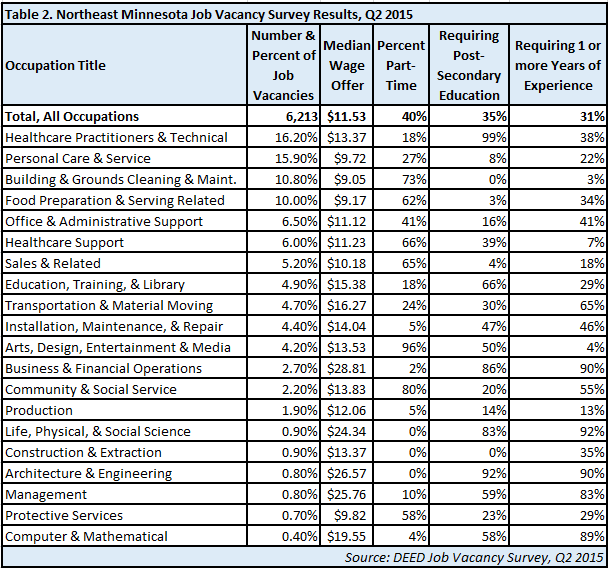 Home to the state's second-largest metro, the Northeast Region has a strong industrial sector, tied largely to the area's abundant natural resources.
Home to the state's second-largest metro, the Northeast Region has a strong industrial sector, tied largely to the area's abundant natural resources.
Most of the manufacturing base centers on mining and forest products industries. More than half of the sector's employment is in paper and machinery manufacturing.
Want the freshest data delivered by email? Subscribe to our regional newsletters.
9/22/2015 10:31:51 AM
Erik White
DEED recently released new data from their Job Vacancy Survey Program, reflecting the number of job openings, typical wage offerings, and typical education requirements by occupation and industry, by region and statewide.
Job vacancies in Northeast Minnesota climbed to 6,213 in the 2nd quarter of 2015, a 15.7 percent increase from the same period a year ago. That matched the statewide increase, though the number of job vacancies actually dropped in the region from 8,410 openings during 4th Quarter 2014 while the state saw the number of job vacancies increase by about 10% during this time frame (see Table 1).

The greatest percent of vacancies in Northeast were found in Healthcare Practitioners and Technical, Personal Care and Service, Building and Grounds Cleaning and Maintenance, and Food Preparation occupations, which each had at least 600 job vacancies in the most recent period. The median wage offer for all job vacancies in the region was $11.53, with about 40% of the openings considered part-time, which is defined as less than 35 hours per week. Only about one-third of the job vacancies required post-secondary education or work experience as a qualification for the position (see Table 2).

The results of the recent Job Vacancy Survey continue indicate a tightening of the labor market here in Northeast Minnesota. With only 1.4 unemployed workers for each job vacancy, businesses will be forced to tap different sources to replace retiring Baby Boomers or other workers and attract and retain them. For example, the median wage offer for job vacancies has increased considerably with the latest survey, and we have already examined the wage growth in the region that has occurred recently, which will be a benefit from a tighter labor market to workers in the region. Other options, such as flexible scheduling or offering benefits for part-time work, may become more common as companies try to fill their workforce needs.
Contact Erik White at 218-302-8413.